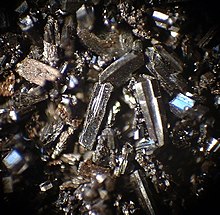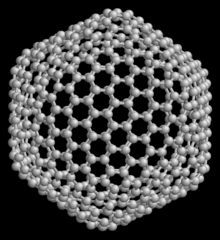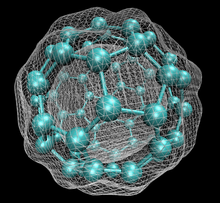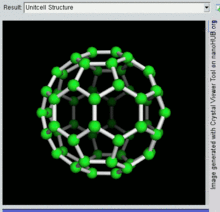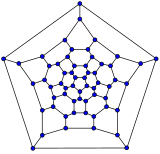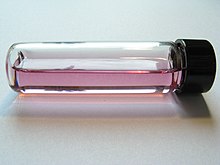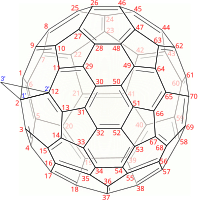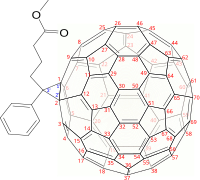Model of the C60 fullerene (buckminsterfullerene).
Model of the C20 fullerene.
Model of a carbon nanotube.
C60 fullerite (bulk solid C60).
A fullerene is an allotrope of carbon whose molecule consists of carbon
atoms connected by single and double bonds so as to form a closed or
partially closed mesh, with fused rings of five to seven atoms. The
molecule may be a hollow sphere, ellipsoid, tube, or many other shapes and sizes. Graphene (isolated atomic layers of graphite), which is a flat mesh of regular hexagonal rings, can be seen as an extreme member of the family.
Fullerenes with a closed mesh topology are informally denoted by their elemental formula Cn, often written Cn, where n is the number of carbon atoms. However, for some values of n there maybe more than one isomer.
The family is named after buckminsterfullerene (C60), the most famous member, which in turn is named after Buckminster Fuller. The closed fullerenes, especially C60, are also informally called buckyballs for their obvious resemblance to the standard ball of association football ("soccer"). Nested closed fullerenes have been named bucky onions. Cylindrical fullerenes are also called carbon nanotubes or buckytubes. The bulk solid form of pure or mixed fullerenes is called fullerite.
Fullerenes had been predicted for some time, but only after their accidental synthesis in 1985 were they detected in nature and outer space.
The discovery of fullerenes greatly expanded the number of known
allotropes of carbon, which had previously been limited to graphite, diamond, and amorphous carbon such as soot and charcoal.
They have been the subject of intense research, both for their
chemistry and for their technological applications, especially in materials science, electronics, and nanotechnology.
History
The icosahedral fullerene C
540, another member of the family of fullerenes
540, another member of the family of fullerenes
Predictions and limited observations
The icosahedral C
60H60 cage was mentioned in 1965 as a possible topological structure. Eiji Osawa of Toyohashi University of Technology predicted the existence of C
60 in 1970. He noticed that the structure of a corannulene molecule was a subset of the shape of a soccer ball, and hypothesised that a full ball shape could also exist. Japanese scientific journals reported his idea, but neither it nor any translations of it reached Europe or the Americas.
60H60 cage was mentioned in 1965 as a possible topological structure. Eiji Osawa of Toyohashi University of Technology predicted the existence of C
60 in 1970. He noticed that the structure of a corannulene molecule was a subset of the shape of a soccer ball, and hypothesised that a full ball shape could also exist. Japanese scientific journals reported his idea, but neither it nor any translations of it reached Europe or the Americas.
Also in 1970, R. W. Henson (then of the UK Atomic Energy Research Establishment) proposed the C
60 structure and made a model of it. Unfortunately, the evidence for that new form of carbon was very weak at the time, so the proposal and was met with skepticism, and was never published. It was acknowledged only in 1999.
60 structure and made a model of it. Unfortunately, the evidence for that new form of carbon was very weak at the time, so the proposal and was met with skepticism, and was never published. It was acknowledged only in 1999.
In 1973, independently from Henson, a group of scientists from the USSR made a quantum-chemical analysis of the stability of C
60 and calculated its electronic structure. The paper was published in 1973, but the scientific community did not gave much importance to this theoretical prediction.
60 and calculated its electronic structure. The paper was published in 1973, but the scientific community did not gave much importance to this theoretical prediction.
Around 1980, Sumio Iijima identified the molecule of C60 from an electron microscope image of carbon black, where it formed the core of a particle with the structure of a "bucky onion".
Discovery of C60
In 1985 Harold Kroto of the University of Sussex, working with James R. Heath, Sean O'Brien, Robert Curl and Richard Smalley from Rice University, discovered fullerenes in the sooty residue created by vaporising carbon in a helium atmosphere. In the mass spectrum
of the product, discrete peaks appeared corresponding to molecules with
the exact mass of sixty or seventy or more carbon atoms, namely C
60 and C
70. The team identified their structure as the now familiar "buckyballs".
60 and C
70. The team identified their structure as the now familiar "buckyballs".
The name "buckminsterfullerene" was eventually chosen for C60 by the discoverers as an homage to American architect Buckminster Fuller for the vague similarity of the structure to the geodesic domes which he popularized; which, if they were extended to a full sphere, would also have the icosahedral symmetry group. The "ene" ending was chosen to indicate that the carbons are unsaturated,
being connected to only three other atoms instead of the normal four.
The shortened named "fullerene" eventually came to be applied to the
whole family.
Kroto, Curl, and Smalley were awarded the 1996 Nobel Prize in Chemistry for their roles in the discovery of this class of molecules.
Further developments
Kroto and the Rice team already discovered other fullerenes besides C60, and the list was much expanded in the following years. Carbon nanotubes were first discovered and synthesized in 1991.
After their discovery, minute quantities of fullerenes were found to be produced in sooty flames, and by lightning discharges in the atmosphere. In 1992, fullerenes were found in a family of minerals known as shungites in Karelia, Russia.
The production techniques were improved by many scientists, including Donald Huffman, Wolfgang Krätschmer, Lowell D. Lamb, and Konstantinos Fostiropoulos. Thanks to their efforts, by 1990 it was relatively easy to produce gram-sized samples of fullerene powder. Fullerene purification remains a challenge to chemists and to a large extent determines fullerene prices.
In 2010, the spectral signatures of C60 and C70 were observed by NASA's Spitzer infrared telescope in a cloud of cosmic dust surrounding a star 6500 light years away.
Kroto commented: "This most exciting breakthrough provides convincing
evidence that the buckyball has, as I long suspected, existed since time
immemorial in the dark recesses of our galaxy." According to astronomer L. Stanghellini, "It’s possible that buckyballs from outer space provided seeds for life on Earth."
Types
There are
two major families of fullerenes, with fairly distinct properties and
applications: the closed buckyballs and the open-ended cylindrical
carbon nanotubes. However, hybrid structures exist between those two classes, such as carbon nanobuds — nanotubes capped by hemispherical meshes or larger "buckybuds".
Buckyballs
upright=0.5C
60 with isosurface of ground state electron density as calculated with DFT
60 with isosurface of ground state electron density as calculated with DFT
Rotating view of C
60, one kind of fullerene
60, one kind of fullerene
Buckminsterfullerene
Buckminsterfullerene is the smallest fullerene molecule containing
pentagonal and hexagonal rings in which no two pentagons share an edge
(which can be destabilizing, as in pentalene). It is also most common in terms of natural occurrence, as it can often be found in soot.
The structure of C
60 is a truncated icosahedron, which resembles an association football ball of the type made of twenty hexagons and twelve pentagons, with a carbon atom at the vertices of each polygon and a bond along each polygon edge.
60 is a truncated icosahedron, which resembles an association football ball of the type made of twenty hexagons and twelve pentagons, with a carbon atom at the vertices of each polygon and a bond along each polygon edge.
The van der Waals diameter of a C
60 molecule is about 1.1 nanometers (nm). The nucleus to nucleus diameter of a C
60 molecule is about 0.71 nm.
60 molecule is about 1.1 nanometers (nm). The nucleus to nucleus diameter of a C
60 molecule is about 0.71 nm.
The C
60 molecule has two bond lengths. The 6:6 ring bonds (between two hexagons) can be considered "double bonds" and are shorter than the 6:5 bonds (between a hexagon and a pentagon). Its average bond length is 1.4 angstroms.
60 molecule has two bond lengths. The 6:6 ring bonds (between two hexagons) can be considered "double bonds" and are shorter than the 6:5 bonds (between a hexagon and a pentagon). Its average bond length is 1.4 angstroms.
Other buckyballs
Another fairly common fullerene is C
70, but fullerenes with 72, 76, 84 and even up to 100 carbon atoms are commonly obtained.
70, but fullerenes with 72, 76, 84 and even up to 100 carbon atoms are commonly obtained.
The smallest fullerene is the dodecahedral C
20. There are no fullerenes with 22 vertices. The number of fullerenes C2n grows with increasing n = 12, 13, 14, ..., roughly in proportion to n9 (sequence A007894 in the OEIS). For instance, there are 1812 non-isomorphic fullerenes C
60. Note that only one form of C
60, the buckminsterfullerene alias truncated icosahedron, has no pair of adjacent pentagons (the smallest such fullerene). To further illustrate the growth, there are 214,127,713 non-isomorphic fullerenes C
200, 15,655,672 of which have no adjacent pentagons. Optimized structures of many fullerene isomers are published and listed on the web.
20. There are no fullerenes with 22 vertices. The number of fullerenes C2n grows with increasing n = 12, 13, 14, ..., roughly in proportion to n9 (sequence A007894 in the OEIS). For instance, there are 1812 non-isomorphic fullerenes C
60. Note that only one form of C
60, the buckminsterfullerene alias truncated icosahedron, has no pair of adjacent pentagons (the smallest such fullerene). To further illustrate the growth, there are 214,127,713 non-isomorphic fullerenes C
200, 15,655,672 of which have no adjacent pentagons. Optimized structures of many fullerene isomers are published and listed on the web.
Heterofullerenes have heteroatoms substituting carbons in cage or tube-shaped structures. They were discovered in 1993 and greatly expand the overall fullerene class of compounds. Notable examples include boron, nitrogen (azafullerene), oxygen, and phosphorus derivatives.
Trimetasphere carbon nanomaterials were discovered by researchers at Virginia Tech and licensed exclusively to Luna Innovations. This class of novel molecules comprises 80 carbon atoms (C
80) forming a sphere which encloses a complex of three metal atoms and one nitrogen atom. These fullerenes encapsulate metals which puts them in the subset referred to as metallofullerenes. Trimetaspheres have the potential for use in diagnostics (as safe imaging agents), therapeutics and in organic solar cells.
80) forming a sphere which encloses a complex of three metal atoms and one nitrogen atom. These fullerenes encapsulate metals which puts them in the subset referred to as metallofullerenes. Trimetaspheres have the potential for use in diagnostics (as safe imaging agents), therapeutics and in organic solar cells.
Carbon nanotubes
Carbon nanotubes
are cylindrical fullerenes. These tubes of carbon are usually only a
few nanometres wide, but they can range from less than a micrometer to
several millimeters in length. They often have closed ends, but can be
open-ended as well. There are also cases in which the tube reduces in
diameter before closing off. Their unique molecular structure results in
extraordinary macroscopic properties, including high tensile strength, high electrical conductivity, high ductility, high heat conductivity, and relative chemical inactivity
(as it is cylindrical and "planar" — that is, it has no "exposed" atoms
that can be easily displaced). One proposed use of carbon nanotubes is
in paper batteries, developed in 2007 by researchers at Rensselaer Polytechnic Institute.
Another highly speculative proposed use in the field of space
technologies is to produce high-tensile carbon cables required by a space elevator.
Derivatives
Buckyballs
and carbon nanotubes have been used as building blocks for a great
varety of derivatives and larger structures, such as
- Nested buckyballs ("carbon nano-onions" or "buckyonions") proposed for lubricants;
- Nested carbon nanotubes ("carbon megatubes");
- Linked "ball-and-chain" dimers (two buckyballs linked by a carbon chain);
- Rings of buckyballs linked together.
Heterofullerenes and non-carbon fullerenes
After the discovery of C60, many fullerenes have been synthesized (or studied theoretically by molecular modeling methods) in which some or all the carbon atoms are replaced by other elements. Inorganic nanotubes, in particular, have attracted much attention.
Silicon
Silicon buckyballs have been created around metal ions.
Boron
A type of buckyball which uses boron atoms, instead of the usual carbon, was predicted and described in 2007. The B
80 structure, with each atom forming 5 or 6 bonds, is predicted to be more stable than the C
60 buckyball. One reason for this given by the researchers is that B
80 is actually more like the original geodesic dome structure popularized by Buckminster Fuller, which uses triangles rather than hexagons. However, this work has been subject to much criticism by quantum chemists as it was concluded that the predicted Ih symmetric structure was vibrationally unstable and the resulting cage undergoes a spontaneous symmetry break, yielding a puckered cage with rare Th symmetry (symmetry of a volleyball). The number of six-member rings in this molecule is 20 and number of five-member rings is 12. There is an additional atom in the center of each six-member ring, bonded to each atom surrounding it. By employing a systematic global search algorithm, later it was found that the previously proposed B80 fullerene is not global minimum for 80 atom boron clusters and hence can not be found in nature. In the same paper by Sandip De et al., it was concluded that boron's energy landscape is significantly different from other fullerenes already found in nature hence pure boron fullerenes are unlikely to exist in nature.
80 structure, with each atom forming 5 or 6 bonds, is predicted to be more stable than the C
60 buckyball. One reason for this given by the researchers is that B
80 is actually more like the original geodesic dome structure popularized by Buckminster Fuller, which uses triangles rather than hexagons. However, this work has been subject to much criticism by quantum chemists as it was concluded that the predicted Ih symmetric structure was vibrationally unstable and the resulting cage undergoes a spontaneous symmetry break, yielding a puckered cage with rare Th symmetry (symmetry of a volleyball). The number of six-member rings in this molecule is 20 and number of five-member rings is 12. There is an additional atom in the center of each six-member ring, bonded to each atom surrounding it. By employing a systematic global search algorithm, later it was found that the previously proposed B80 fullerene is not global minimum for 80 atom boron clusters and hence can not be found in nature. In the same paper by Sandip De et al., it was concluded that boron's energy landscape is significantly different from other fullerenes already found in nature hence pure boron fullerenes are unlikely to exist in nature.
Other elements
Inorganic (carbon-free) fullerene-type structures have been built with the disulfides of molibdenum (MoS2), long used as a graphite-like lubricant, tungsten (WS2), titanium (TiS2) and niobium (NbS2). These materials were found to be stable up to at least 350 tons/cm2 (34.3 GPa).
Properties
Topology
Schlegel diagrams are often used to clarify the 3D structure of closed-shell fullerenes, as 2D projections are often not ideal in this sense.
In mathematical terms, the combinatorial topology
(that is, the carbon atoms and the bonds between them, ignoring their
positions and distances) of a closed-shell fullerene with a simple
sphere-like mean surface (orientable, genus zero)can be represented as a convex polyhedron; more precisely, its one-dimensional
skeleton, consisting of its vertices and edges. The Schlegel diagram is
a projection of that skeleton onto one of the faces of the polyhedron,
through a point just outside that face; so that all other vertices
project inside that face.
- Schlegel diagrams of some fullerenes
The Schlegel diagram of a closed fullerene is a graph that is planar and 3-regular (or "cubic"; meaning that all vertices have degree 3.
A closed fullerene with sphere-like shell must have at least some
cycles that are pentagons or heptagons. More precisely, if all the
faces have 5 or 6 sides, it follows from Euler's polyhedron formula, V−E+F=2 (where V, E, F are the numbers of vertices, edges, and faces), that V must be even, and that there must be exactly 12 pentagons and V/2−10 hexagons. Similar constraints exist if the fullerene has heptagonal (seven-atom) cycles.
Open fullerenes, like carbon nanotubes and graphene, can consist
entirely of hexagonal rings. In theory, a long nanotube with ends joined
to form a closed torus-like sheet could also consist entirely of hexagons.
Bonding
Since
each carbon atom is connected to only three neighbors, instead of the
usual four, it is customary to describe those bonds as being a mixture
of single and double covalent bonds.
Encapsulation
So-called endohedral fullerenes have ions or small molecules incorporated inside the cage atoms.
Research
In
the early 2000s, the chemical and physical properties of fullerenes were
a hot topic in the field of research and development. Popular Science discussed possible uses of fullerenes (graphene) in armor.
In the field of nanotechnology, heat resistance and superconductivity are some of the more heavily studied properties.
There are many calculations that have been done using ab-initio quantum methods applied to fullerenes. By DFT and TD-DFT methods one can obtain IR, Raman and UV spectra. Results of such calculations can be compared with experimental results.
Fullerene is an unusual reactant in many organic reactions such as the Bingel reaction discovered in 1993.
Aromaticity
Researchers
have been able to increase the reactivity of fullerenes by attaching
active groups to their surfaces. Buckminsterfullerene does not exhibit "superaromaticity": that is, the electrons in the hexagonal rings do not delocalize over the whole molecule.
A spherical fullerene of n carbon atoms has n pi-bonding
electrons, free to delocalize. These should try to delocalize over the
whole molecule. The quantum mechanics of such an arrangement should be
like one shell only of the well-known quantum mechanical structure of a
single atom, with a stable filled shell for n = 2, 8, 18, 32, 50, 72, 98, 128, etc.; i.e. twice a perfect square number; but this series does not include 60. This 2(N + 1)2 rule (with N integer) for spherical aromaticity is the three-dimensional analogue of Hückel's rule. The 10+ cation would satisfy this rule, and should be aromatic. This has been shown to be the case using quantum chemical modelling, which showed the existence of strong diamagnetic sphere currents in the cation.
As a result, C
60 in water tends to pick up two more electrons and become an anion. The nC
60 described below may be the result of C
60 trying to form a loose metallic bond.
60 in water tends to pick up two more electrons and become an anion. The nC
60 described below may be the result of C
60 trying to form a loose metallic bond.
Reactions
Polymerization
Under
high pressure and temperature, buckyballs collapse to form various
one-, two-, or three-dimensional carbon frameworks. Single-strand
polymers are formed using the Atom Transfer Radical Addition
Polymerization (ATRAP) route.
"Ultrahard fullerite"
is a coined term frequently used to describe material produced by
high-pressure high-temperature (HPHT) processing of fullerite. Such
treatment converts fullerite into a nanocrystalline form of diamond which has been reported to exhibit remarkable mechanical properties.
Fullerite (scanning electron microscope image)
Chemistry
Fullerenes are stable, but not totally unreactive. The sp2-hybridized carbon atoms, which are at their energy minimum in planar graphite, must be bent to form the closed sphere or tube, which produces angle strain. The characteristic reaction of fullerenes is electrophilic addition at 6,6-double bonds, which reduces angle strain by changing sp2-hybridized carbons into sp3-hybridized ones. The change in hybridized orbitals causes the bond angles to decrease from about 120° in the sp2 orbitals to about 109.5° in the sp3
orbitals. This decrease in bond angles allows for the bonds to bend
less when closing the sphere or tube, and thus, the molecule becomes
more stable.
Other atoms can be trapped inside fullerenes to form inclusion compounds known as endohedral fullerenes. An unusual example is the egg-shaped fullerene Tb3N@C
84, which violates the isolated pentagon rule. Recent evidence for a meteor impact at the end of the Permian period was found by analyzing noble gases so preserved. Metallofullerene-based inoculates using the rhonditic steel process are beginning production as one of the first commercially viable uses of buckyballs.
84, which violates the isolated pentagon rule. Recent evidence for a meteor impact at the end of the Permian period was found by analyzing noble gases so preserved. Metallofullerene-based inoculates using the rhonditic steel process are beginning production as one of the first commercially viable uses of buckyballs.
Solubility
C
60 in solution
60 in solution
C
60 in extra virgin olive oil showing the characteristic purple color of pristine C
60 solutions
60 in extra virgin olive oil showing the characteristic purple color of pristine C
60 solutions
Fullerenes are soluble in many organic solvents, such as toluene, chlorobenzene, and 1,2,3-trichloropropane. Solubilities are generally rather low, like 8 g/L for C60 in carbon disulfide. Still, fullerenes are the only known allotrope of carbon that can be dissolved in common solvents at room temperature. Among the best solvents is 1-chloronaphthalene, which will dissolve 51 g/L of C60.
Solutions of pure buckminsterfullerene have a deep purple color. Solutions of C
70 are a reddish brown. The higher fullerenes C
76 to C
84 have a variety of colors.
70 are a reddish brown. The higher fullerenes C
76 to C
84 have a variety of colors.
Millimeter-sized crystals of C
60 and C
70, both pure and solvated, can be grown from benzene solution. Crystallization of C60 from benzene solution below 30 °C (when solubility is maximum) yields a triclinic solid solvate C
60·4C
6H6. Above 30 °C one obtains solvate-free fcc C
60.
60 and C
70, both pure and solvated, can be grown from benzene solution. Crystallization of C60 from benzene solution below 30 °C (when solubility is maximum) yields a triclinic solid solvate C
60·4C
6H6. Above 30 °C one obtains solvate-free fcc C
60.
Quantum mechanics
In 1999, researchers from the University of Vienna demonstrated that wave-particle duality applied to molecules such as fullerene.
Superconductivity
Fullerenes are normally electrical insulators, but when crystallized
with alkali metals, the resultant compound can be conducting or even
superconducting.
Chirality
Some fullerenes (e.g. C
76, C
78, C
80, and C
84) are inherently chiral because they are D2-symmetric, and have been successfully resolved. Research efforts are ongoing to develop specific sensors for their enantiomers.
76, C
78, C
80, and C
84) are inherently chiral because they are D2-symmetric, and have been successfully resolved. Research efforts are ongoing to develop specific sensors for their enantiomers.
Stability
Two
theories have been proposed to describe the molecular mechanisms that
make fullerenes. The older, “bottom-up” theory proposes that they are
built atom-by-atom. The alternative “top-down” approach claims that
fullerenes form when much larger structures break into constituent
parts.
In 2013 researchers discovered that asymmetrical fullerenes
formed from larger structures settle into stable fullerenes. The
synthesized substance was a particular metallofullerene consisting of 84 carbon atoms with two additional carbon atoms and two yttrium atoms inside the cage. The process produced approximately 100 micrograms.
However, they found that the asymmetrical molecule could
theoretically collapse to form nearly every known fullerene and
metallofullerene. Minor perturbations involving the breaking of a few
molecular bonds cause the cage to become highly symmetrical and stable.
This insight supports the theory that fullerenes can be formed from
graphene when the appropriate molecular bonds are severed.
Systematic naming
According to the IUPAC, to name a fullerene, one must cite the number of member atoms for the rings which comprise the fullerene, its symmetry point group in the Schoenflies notation, and the total number of atoms. For example, buckminsterfullerene C60 is systematically named (C
60-Ih)[5,6]fullerene. The name of the point group should be retained in any derivative of said fullerene, even if that symmetry is lost by the derivation.
60-Ih)[5,6]fullerene. The name of the point group should be retained in any derivative of said fullerene, even if that symmetry is lost by the derivation.
To indicate the position of substituted or attached elements, the
fullerene atoms are usually numbered in spiral pathway, usually
starting with the ring on one of the main axes. If the structure of the
fullerene does not allow such numbering, another starting atom was
chosen to still achieve a spiral path sequence.
The latter is the case for C70, which is (C
70-D5h(6))[5,6]fullerene in IUPAC notation. The symmetry D5h(6) means that this is the isomer where the C5 axis goes through a pentagon surrounded by hexagons rather than pentagons.
70-D5h(6))[5,6]fullerene in IUPAC notation. The symmetry D5h(6) means that this is the isomer where the C5 axis goes through a pentagon surrounded by hexagons rather than pentagons.
In IUPAC's nomenclature, fully saturated analogues of fullerenes are called fulleranes. If the mesh has other element(s) substituted for one or more cabons, the compound is named a heterofullerene. If a double bond is replaced by a methylene bridge –CH
2–, the resulting structure is a homofullerene. If an atom is fully deleted and missing valences saturated with hydrogen atoms, it is a norfullerene. When bonds are removed (both sigma and pi), the compound becomes secofullerene; if some new bonds are added in an unconventional order, it is a cyclofullerene.
2–, the resulting structure is a homofullerene. If an atom is fully deleted and missing valences saturated with hydrogen atoms, it is a norfullerene. When bonds are removed (both sigma and pi), the compound becomes secofullerene; if some new bonds are added in an unconventional order, it is a cyclofullerene.
Production
Fullerene
production generally starts by producing fullerene-rich soot. The
original (and still current) method was to send a large electric current
between two nearby graphite electrodes in an inert atmosphere. The resulting electric arc vaporizes the carbon into a plasma that then cools into sooty residue. Alternatively, soot is produced by laser ablation of graphite or pyrolysis of aromatic hydrocarbons. Combustion is the most efficient process, developed at MIT.
These processes yield a mixture of various fullerenes and other
forms of carbon. The fullerenes are then extracted from the soot using appropriate organic solvents and separated by chromatography. One can obtain milligram quantities of fullerenes with 80 atoms or more.
C76, C78 and C84 are available commercially.
Applications
Fullerenes have been extensively used for several biomedical applications including the design of high-performance MRI contrast agents, X-ray imaging contrast agents, photodynamic therapy and drug and gene delivery, summarized in several comprehensive reviews.
Medical research
In April 2003, fullerenes were under study for potential medicinal use: binding specific antibiotics to the structure to target resistant bacteria and even target certain cancer cells such as melanoma. The October 2005 issue of Chemistry & Biology contained an article describing the use of fullerenes as light-activated antimicrobial agents.
Tumor research
While past cancer research has involved radiation therapy, photodynamic therapy
is important to study because breakthroughs in treatments for tumor
cells will give more options to patients with different conditions.
Recent experiments using HeLa cells in cancer research involves the development of new photosensitizers
with increased ability to be absorbed by cancer cells and still trigger
cell death. It is also important that a new photosensitizer does not
stay in the body for a long time to prevent unwanted cell damage.
Fullerenes can be made to be absorbed by HeLa cells. The C
60 derivatives can be delivered to the cells by using the functional groups L-phenylalanine, folic acid, and L-arginine among others.
60 derivatives can be delivered to the cells by using the functional groups L-phenylalanine, folic acid, and L-arginine among others.
Functionalizing the fullerenes aims to increase the solubility of
the molecule by the cancer cells. Cancer cells take up these molecules
at an increased rate because of an upregulation of transporters in the
cancer cell, in this case amino acid transporters will bring in the
L-arginine and L-phenylalanine functional groups of the fullerenes.
Once absorbed by the cells, the C
60 derivatives would react to light radiation by turning molecular oxygen into reactive oxygen which triggers apoptosis in the HeLa cells and other cancer cells that can absorb the fullerene molecule. This research shows that a reactive substance can target cancer cells and then be triggered by light radiation, minimizing damage to surrounding tissues while undergoing treatment.
60 derivatives would react to light radiation by turning molecular oxygen into reactive oxygen which triggers apoptosis in the HeLa cells and other cancer cells that can absorb the fullerene molecule. This research shows that a reactive substance can target cancer cells and then be triggered by light radiation, minimizing damage to surrounding tissues while undergoing treatment.
When absorbed by cancer cells and exposed to light radiation, the
reaction that creates reactive oxygen damages the DNA, proteins, and
lipids that make up the cancer cell. This cellular damage forces the
cancerous cell to go through apoptosis, which can lead to the reduction
in size of a tumor. Once the light radiation treatment is finished the
fullerene will reabsorb the free radicals to prevent damage of other
tissues.
Since this treatment focuses on cancer cells, it is a good option for
patients whose cancer cells are within reach of light radiation. As this
research continues, the treatment may penetrate deeper into the body
and be absorbed by cancer cells more effectively.
Safety and toxicity
Lalwani et al. published a comprehensive review on fullerene toxicity in 2013.
These authors review the works on fullerene toxicity beginning in the
early 1990s to present, and conclude that very little evidence gathered
since the discovery of fullerenes indicate that C
60 is toxic. The toxicity of these carbon nanoparticles is not only dose- and time-dependent, but also depends on a number of other factors such as:
60 is toxic. The toxicity of these carbon nanoparticles is not only dose- and time-dependent, but also depends on a number of other factors such as:
- Type (e.g.: C
60, C
70, M@C
60, M@C
82; - Functional groups used to water-solubilize these nanoparticles (e.g.: OH, COOH);
- Method of administration (e.g.: intravenous, intraperitoneal).
The authors therefore recommend assessing the pharmacology of every
new fullerene- or metallofullerene-based complex individually as a
different compound.
Popular culture
Examples of fullerenes in popular culture
are numerous. Fullerenes appeared in fiction well before scientists
took serious interest in them. In a humorously speculative 1966 column
for New Scientist, David Jones
suggested that it may be possible to create giant hollow carbon
molecules by distorting a plane hexagonal net by the addition of
impurity atoms.



